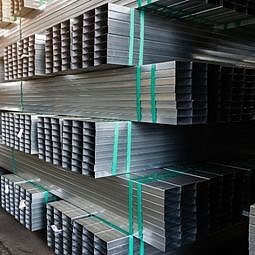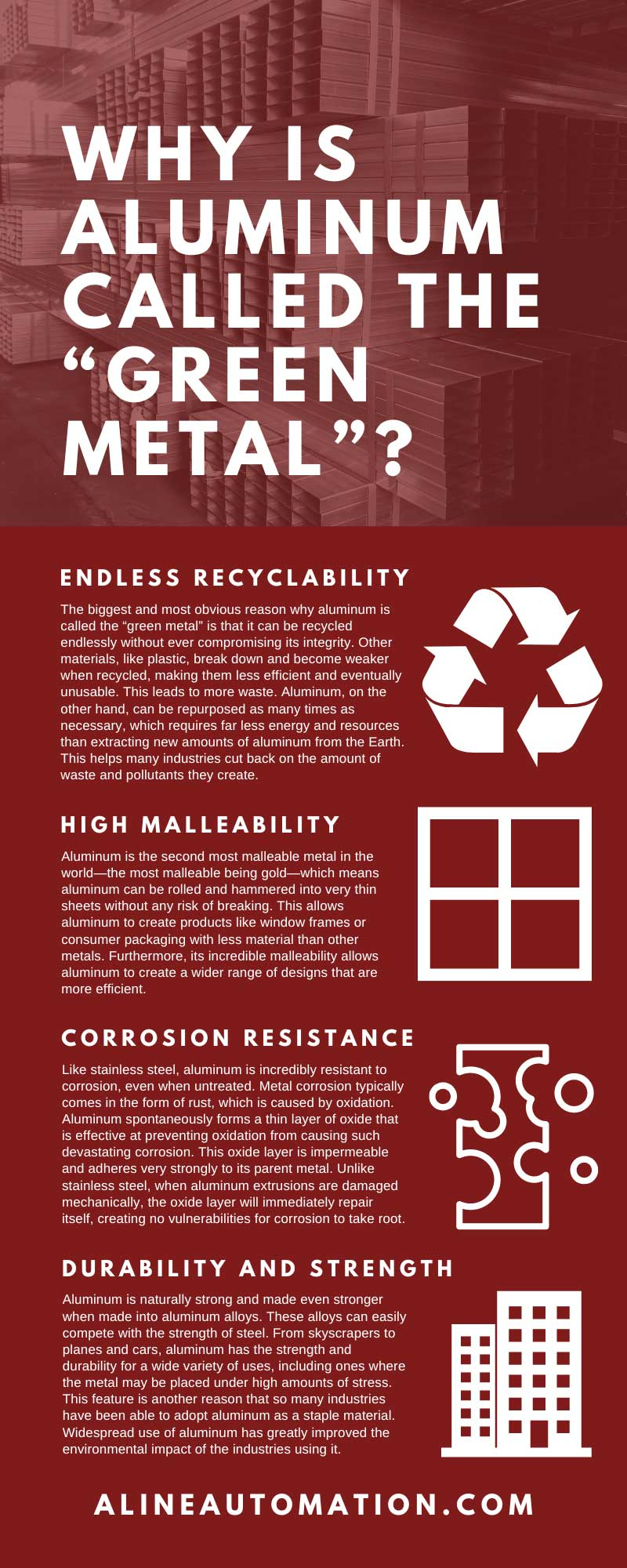
Between advancements in technology and the rising awareness of humanity’s impact on the Earth, aluminum extrusion fabrication has sharply risen in demand. Many industries have adopted aluminum as their material of choice for its practical and environmental benefits. In fact, those environmental benefits are the reason extruded aluminum is called “the green metal.” As experts in aluminum extrusion, allow us to shed some light on what makes this material so great.
The biggest and most obvious reason why aluminum is called the “green metal” is that it can be recycled endlessly without ever compromising its integrity. Other materials, like plastic, break down and become weaker when recycled, making them less efficient and eventually unusable. This leads to more waste. Aluminum, on the other hand, can be repurposed as many times as necessary, which requires far less energy and resources than extracting new amounts of aluminum from the Earth. This helps many industries cut back on the amount of waste and pollutants they create.
This endless recyclability is further beneficial because it avoids the issue of finite resources. You can’t run out of aluminum if it is constantly being repurposed and put back into the supply chain.
Aluminum is the second most malleable metal in the world—the most malleable being gold—which means aluminum can be rolled and hammered into very thin sheets without any risk of breaking. This allows aluminum to create products like window frames or consumer packaging with less material than other metals. Furthermore, its incredible malleability allows aluminum to create a wider range of designs that are more efficient. In comparison, less malleable metals may require more materials for more convoluted designs because they can’t form certain shapes.
Like stainless steel, aluminum is incredibly resistant to corrosion, even when untreated. Metal corrosion typically comes in the form of rust, which is caused by oxidation. Aluminum spontaneously forms a thin layer of oxide that is effective at preventing oxidation from causing such devastating corrosion. This oxide layer is impermeable and adheres very strongly to its parent metal. Unlike stainless steel, when aluminum extrusions are damaged mechanically, the oxide layer will immediately repair itself, creating no vulnerabilities for corrosion to take root.
While corrosion resistance does not mean invulnerability to corrosion, it should be noted that rusty or damaged aluminum does not have to be disposed of. Aluminum can be recycled and put right back to use so that nothing is ever wasted.
Aluminum is naturally strong and made even stronger when made into aluminum alloys. These alloys can easily compete with the strength of steel. From skyscrapers to planes and cars, aluminum has the strength and durability for a wide variety of uses, including ones where the metal may be placed under high amounts of stress. This feature is another reason that so many industries have been able to adopt aluminum as a staple material. Widespread use of aluminum has greatly improved the environmental impact of the industries using it. Furthermore, because of its greater malleability, building and car designs have become much more efficient and innovative, allowing greater creativity while also reducing the impact on the environment.
Aluminum extrusions are highly conductive to thermal energy. This helps improve our environment by helping us manage thermal insulation in our homes. Proper insulation reduces how much energy is needed to keep homes heated or cooled. Normally, high conductivity is not conducive to insulation, but by putting small breaks in aluminum extrusions, the air serves as a poor conductor that keeps warm or cool air from entering or exiting your home. Alternatively, aluminum foil is used in reflective insulation, as aluminum is good at reflecting heat and light away from a building.
In the cold, however, aluminum extrusions become even stronger. While aluminum extrusions are already fantastic building materials, they absolutely thrive in cold environments and become more durable than other materials. Aluminum is perfect for enduring harsh weather like snow, sleet, hail, and ice.
One unique aspect of aluminum is that, despite its strength, it is actually incredibly lightweight. This makes transporting aluminum materials much more energy efficient because trucks and other vehicles do not need to consume as much fuel to compensate for the weight. In fact, this is the reason that all modern cars, planes, boats, and vehicle chassis are created out of aluminum—to get better gas mileage. Considering how many cars are on the road every day, reducing fuel consumption is imperative. Aluminum chassis have greatly reduced the environmental impact of cars, which is another reason aluminum is considered the greenest metal.
While strength and durability extend the life span of aluminum because it is difficult for it to break or corrode, aluminum is also just naturally long-lasting. Aluminum extrusions can easily last for decades. The cut-off value in construction is 60 years before it needs to be replaced.
Furthermore, if the aluminum does become damaged, the aluminum oxide layer instantaneously repairs itself and ensures the aluminum isn’t exposed to oxidization. This makes it easy for the aluminum to be repaired or recycled without worry that it’s worse off than before. This long life span, combined with the ease and affordability of recycling aluminum, makes any application of aluminum extrusions incredibly energy efficient and beneficial for fighting climate change.
Aluminum is notable for being strong, practical, and environmentally friendly. It helps make many industries more efficient and sustainable. Every industry that has adopted aluminum extrusions and other aluminum materials has found both their business and their impact on the environment to be greatly improved, making it an all-around great material to invest in.
For all these reasons, aluminum has more than earned itself the title of “the green metal.” It should be given the attention it deserves as we turn to find ways to reduce or eliminate climate change. Aluminum has improved the designs of everything from your home to your car and many of the products you use every day. It makes them so much more efficient and friendlier to the environment.
